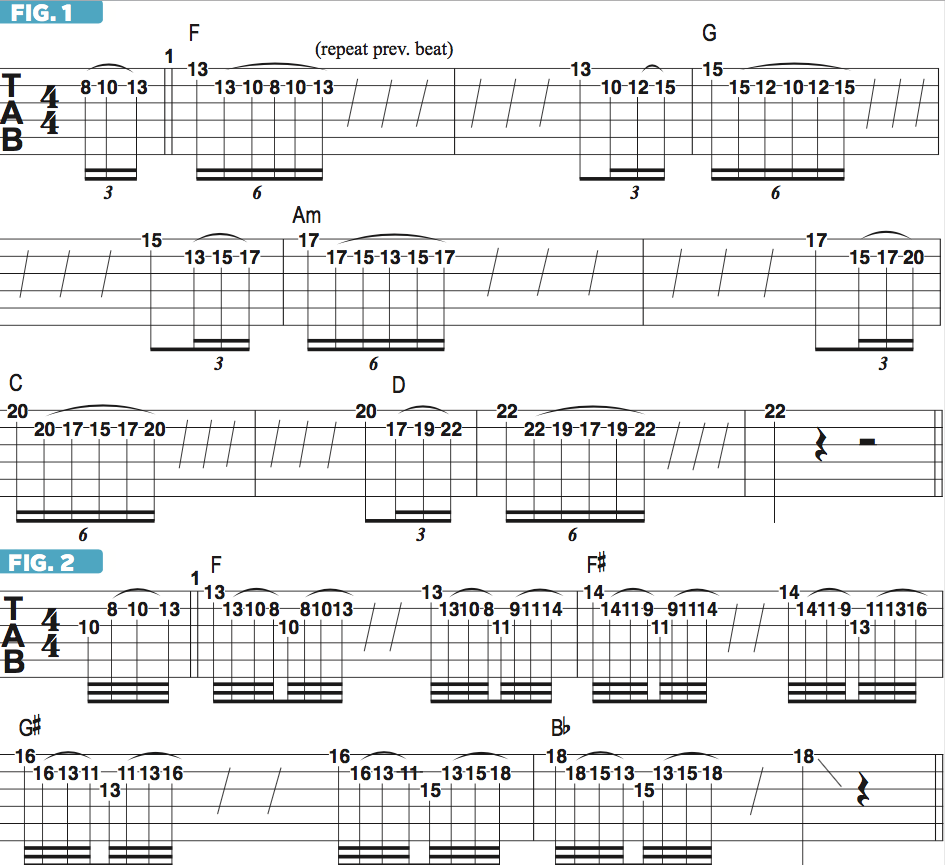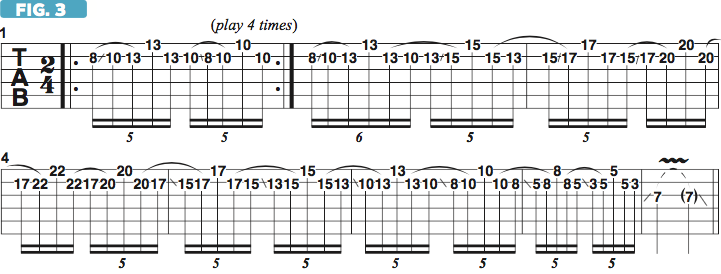How to Use "Legato Rolling" to Play Fast
This month, I’d like to show you a great way to play fast, seamless note sequences using double hammer-ons and pull-offs. The licks shown here are all built from three-notes-per-string shapes and can be thought of as being in the key of D minor, or its relative major key, F (major). Throughout the examples, I perform three notes on the B string and alternate between adding an additional note on the high E string or on both the high E and G strings. The idea with the double hammer-ons and pull-offs is that only the initial note on the string is picked; those that follow are all sounded with unpicked legato articulations, resulting in a smooth, fluid sound.
I begin FIGURE 1 by picking G on the B string’s eighth fret then perform a double hammer-on to A and C, at the 10th and 13th frets, respectively, using my first, second and fourth fingers. I then “roll” my pinkie over to the F note on high E string’s 13th fret, then roll back over to C and perform a double pull-off back to A and G. This results in a six-note pattern, or sextuplet, on each beat.
At the end of bar 2, I shift the pattern up a whole step, starting on A, at the 10th fret, and hammer-on up to B and D, followed by a high G on the first string. The lick continues to progressively move up the fretboard, ending in 17th position, with the highest note sounded at the 22nd fret.
A great twist here is to add a note to the sequence, resulting in the eight-note phrases shown in FIGURE 2. The added note falls on the G string and is fretted with the middle finger. In bar 2, I slide up one fret, transposing the lick from F (or Dm) to F# (or Ebm). In bar 3, I move up a whole step to G# (or Fm), and in bar 4 I move up another whole step to Bb (or Gm).

Another cool way to move this idea up and down the fretboard is to change the fingering slightly when moving from one position to the next and employ a finger slide. As shown in FIGURE 3, I replace the double hammer-on at the beginning of the lick with an ascending slide and hammer-on. After reaching the highest note, I descend in reverse order, with a pull-off and slide. In bars 1 and 2, I repeatedly alternate between 10th and eighth positions, and then in bars 3 into bar 4 I steadily ascend with the sequence. On beat two of bar 4, I reverse the note order and move back down through each previous pattern.

Try applying this concept to other scales, keys and string groups. You’ll find endless possibilities for creating fast, seamless lines utilizing this approach.
This is my last column for the time being. I hope you’ve enjoyed and benefited from these lessons. See you out on the road!
Get The Pick Newsletter
All the latest guitar news, interviews, lessons, reviews, deals and more, direct to your inbox!
“He combined the passion of Gary Moore with riffs inspired by Zeppelin and Deep Purple, plus unexpected melodic twists like Ritchie Blackmore”: He was one of ’80s rock’s great journeymen – and his searing hot lead work inspired Marty Friedman
How to get better at guitar – 10 proven ways to improve your playing fast










